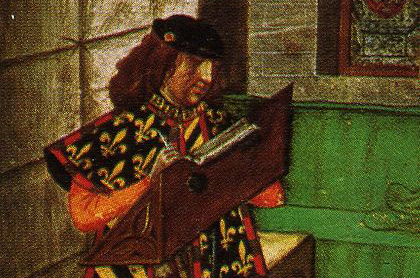Are there eyewitness accounts of the battle of Agincourt?
By Dan Spencer
A small number of accounts survive from the period of men who claimed to have been present at the battle.
These exist in a type of document known as a chronicle, which generally took the form of historical events placed in chronological order. Traditionally these had tended to be written in Latin on parchment by monastic writers, although increasingly in the fifteenth century they were also written by the laity in the vernacular. In most cases they were only ever intended to be read by a very small number of people, such as the writer’s monastic community or a noble household and were reliant on second-hand testimony. In some cases, however, chroniclers were able to draw upon their own experiences of events. Five surviving accounts from the period claim that the writer was present at the battle, which each provide evidence of varying interest and quality.
The unnamed author of the Gesta Henrici Quinti (1417) appears to have been a member of a priestly order attached to the royal household. His main purpose in writing the chronicle, which runs from Henry V’s coronation on 9 April until November 1416, was to glorify the king as a devout Christian prince blessed by the approval of God. The author took part in the expedition and so provides a comprehensive account of the campaign up until the day of the battle. He states he was at present at the battlefield but was confined to the rear of the English army as he ‘…was then sitting on a horse among the baggage at the rear of the battle’. Therefore, despite being at Agincourt, he was undoubtedly reliant on the second hand accounts of other participants in the engagement. For an English translation of the Gesta Henrici Quinti click here.
Another eye witness account of the battle is provided by John Hardyng’s Chronicle (first version 1457 and second version 1464). Hardyng was born in the north of England, possibly Northumberland, in 1378. By his own testimony, he claimed to have served with Sir Robert Umfraville on the 1415 campaign to France. Yet no evidence has been found for his participation in the expedition from the surviving muster rolls, and he only mentions his presence in the second version of his chronicle. It is questionable therefore whether he actually served on the campaign at all. Furthermore both versions were written up more than thirty years after the battle, about which they have relatively little to say.
Two further accounts are provided by writers from Picardy, Jean Waurin and Jean Le Févre (1444-1460s). According to Waurin he was fifteen at the time of the battle with the French army, whereas Févre was nineteen and with the English army. It appears that Févre was in the service of the heralds, whilst it is unclear whether Waurin was a combatant or not. Both men, however, wrote their chronicles at least thirty years after the battle, and drew heavily upon another chronicler, Enguerrand de Monstrelet, whose work was finished in 1447. This, together with the desire of the authors to present a pro-Burgundian account of events, means that their testimony also needs to be treated with care.
The final account is provided by Ghillebert de Lannoy, lord of Willerval, who was captured at the battle. Ghillebert was twenty-nine years old in 1415 and was the chamberlain to Philip, count of Charolais, the eldest son of John the Fearless, duke of Burgundy. He fought as a man-at-arms at the battle where he was wounded and left for dead. After being discovered amongst the bodies he was taken captive and was lucky to survive the subsequent killing of the prisoners. Ghillebert was subsequently taken as a prisoner to England and was freed by 1416. For more information on his reminiscences click here.
This information came from Anne Curry, The Battle of Agincourt: Sources and Interpretations (Woodbridge: The Boydell Press, 2009), pp. 15-16, 22-3, 35, 78, 135; Chris Given-Wilson, Chronicles: The Writings of History in Medieval England (London: Cambridge University Press, 2004), pp. xix, 1
Image of Jean le Févre (circa 1450) from a picture in the Bibliothéque Nationale in Paris, taken from Wikipedia and is in the Public Domain

